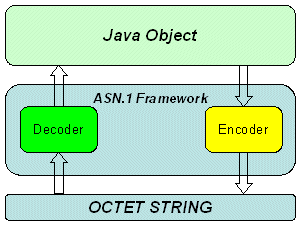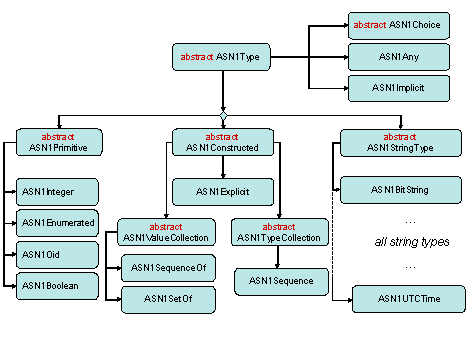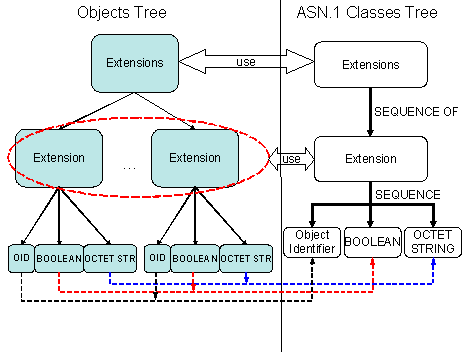
The information on these pages may be out of date, or may refer to
resources that have moved or have been made read-only.
For more information please refer to the
Apache Attic
| Version | Version Information | Date |
|---|---|---|
| Initial version |
Nadya Morozova, Stepan Mishura: document created Special thanks to Sergey Dmitriev for assistance |
November 16, 2005 |
| Formatting update | Nadya Morozova | September 21, 2006 |
This document introduces the ASN.1 (Abstract Syntax Notation) framework delivered as part of the Harmony classlibrary. This document provides an overview of ASN.1 types and encoding rules with focus on the characteristics of the current implementation. The document gives details on the framework design and provides an overall description of the ASN.1 package.
The target audience for the document includes a wide community of engineers interested in using ASN.1 and in further work with the product to contribute to its development. The document assumes that readers are familiar with the ASN.1 notation and the Java* programming language.
This document uses the unified conventions for the Harmony documentation kit.
ASN.1 (Abstract Syntax Notation One) is an international standard of notation used to specify data structures with a high level of abstraction, which is reflected in the ASN.1 specification [2]. ASN.1 is fully platform- and language-independent. ASN.1 goes with the encoding rules, which determine how to represent a value of an abstract type as a string of octets [3].
The Java* API specification [1] employs ASN.1 in the following ways:
To learn more about ASN.1, you can use online documentation [4], [5], and publications [6], [7].
ASN.1 has the following basic types:
ANY and CHOICE.
These types are used to specify a wide range of other abstract types, as shown in Example 1.
This example is based on RFC 3280 [8].
Extensions ::= SEQUENCE SIZE (1..MAX) OF Extension
Extension ::= SEQUENCE {
extnID OBJECT IDENTIFIER,
critical BOOLEAN DEFAULT FALSE,
extnValue OCTET STRING
}
Version ::= INTEGER { v1(0), v2(1), v3(2) }
In this example, the basic ASN.1 types SEQUENCE, OBJECT IDENTIFIER,
BOOLEAN and OCTET STRING are used to specify a new abstract
type Extension. The newly created type is then used with another basic
type SEQUENCE OF to describe the Extensions type. The
ASN.1 INTEGER type is used to specify the Version abstract
type and to provide constraints for this type.
This part of the document describes the ASN.1 framework as a whole, defines the mapping principles to establish the correspondence between ASN.1 and Java* types, and represents the hierarchy of ASN.1 types representation in the current framework.
The ASN.1 framework provides a common, easy and efficient approach for working with ASN.1 basic types, notations and encoding rules. This framework can be described as a layer between a Java* object and its ASN.1 encoded form, as shown in Figure 1.

Figure 1: ASN.1 Framework Layer
The Harmony ASN.1 framework is characterized by:
The framework enables the following:
Note
The current ASN.1 framework is a partial implementation of the ASN.1 and encoding rules specifications. This framework covers certain ASN.1 basic types and basic encoding rules (BER), and provides most restrictions employed by the distinguished encoding rules (DER).
The framework maps all ASN.1 abstract types and notations to Java* primitive types or Java* classes.
The notations in Example 1 can be represented as the following Java* classes:
public class Extension {
private String extnID;
private boolean critical;
private byte extnValue[];
}
public class Extensions {
// contains elements of Extension class
private List extensions;
}
The Extension notation corresponds to a Java* class
with three fields, where every field corresponds to one entry in the Extension
notation. For example, the critical BOOLEAN DEFAULT FALSE field in
the Extension notation corresponds to the boolean critical
field in the Java* class. The Extensions notation
equals to a Java* class with a field that contains an ordered collection
of the instances of the Extension class.
The table below describes the default mapping ASN.1 types to Java* types, and indicates the class providing the specified mapping in the current framework.
| ASN.1 Type | Java* Type | Framework Class | |
|---|---|---|---|
| Primitive | |||
INTEGER
|
byte[]
|
ASN1Integer
|
|
ENUMERATED
|
byte[]
|
ASN1Enumerated
|
|
OBJECT IDENTIFIER
|
int[]
|
ASN1Oid
|
|
BOOLEAN
|
java.lang.Boolean
|
ASN1Boolean
|
|
| String |
BitString
|
asn1.BitString
|
ASN1BitString
|
OctetString
|
byte[]
|
ASN1OctetString
|
|
PrintableString
|
java.lang.String
|
ASN1StringType
|
|
T61String
|
java.lang.String
|
ASN1StringType
|
|
IA5String
|
java.lang.String
|
ASN1StringType
|
|
UTF8String
|
java.lang.String
|
ASN1StringType
|
|
BMPString
|
java.lang.String
|
ASN1StringType
|
|
GeneralString
|
java.lang.String
|
ASN1StringType
|
|
TeletexString
|
java.lang.String
|
ASN1StringType
|
|
UniversalString
|
java.lang.String
|
ASN1StringType
|
|
UTCTime
|
java.util.Date
|
ASN1UTCTime
|
|
GeneralizedTime
|
java.util.Date
|
ASN1GeneralizedTime
|
|
| Constructed |
SEQUENCE
|
Object[]
|
ASN1Sequence
|
SEQUENCE OF
|
java.util.List
|
ASN1SequenceOf
|
|
SET OF
|
java.util.List
|
ASN1SetOf
|
|
| Tagged |
EXPLICIT
|
based type |
ASN1Explicit
|
IMPLICIT
|
based type |
ASN1Implicit
|
|
| Other |
ANY
|
byte[]
|
ASN1Any
|
CHOICE
|
one of chosen types |
ASN1Choice
|
Basic ASN.1 types are in the org.apache.harmony.security.asn1 package
in accordance with the hierarchy shown in Figure 2.

Figure 2: Class Hierarchy
The subsequent sections provide as short description of the classes included in the package.
INTEGER type that denotes an arbitrary
integer with positive, negative, or zero values and any magnitude. Because an integer
value is not restricted, it is up to the application class to choose the Java*
type for storing the integer value, for example, an instance of the java.math.BigInteger
class. By default, an integer value is stored in an array of bytes.
ENUMERATED type that denotes a set
of integer values. The implementation of this class is similar to that of the
ASN1Integer class.
OBJECT IDENTIFIER type. This type is
a sequence of integer components that identifies an entity, such as an organization
or an algorithm. Integer components have no negative values. An OBJECT IDENTIFIER
value includes at least two components. The corresponding Java*
type is an array of integer values.
BOOLEAN type, which corresponds to
the java.lang.Boolean Java* class.
BMPString, IA5String,
GeneralString, PrintableString, TeletexString, UniversalString, and UTF8String.
The class maps all these types to the java.lang.String object.
Note
The current implementation does not verify allowed characters for any of ASN.1 restricted
characters types. The class only stores and retrieves contents bytes to and from
the String object.
BitString type. The corresponding Java* class is BitString included in the asn1
package. The class provides implementation for decoding or encoding BitString
objects.
Note
A special use case for this ASN.1 type exists, when the type is declared as Named
BitString. For example:
Keys ::= BIT STRING {
Key1 (0),
Key2 (1),
MyKey (2)
}
In this case, the BER specification [3] enables adding
and removing any number of trailing to and from the basic encoding. To provide a
correct type implementation, use the ASN1Bitstring.ASN1NamedBitList
class. By default, the class maps the ASN.1 Named BitString type to
an array of primitive boolean values.
OctetString type, which corresponds
to the Java* type of an array of bytes.
UTCTime type. The corresponding Java* class is java.util.Date.
GeneralizedTime type. The corresponding
Java* class is java.util.Date.
integer,
boolean, ANY, then an initialization array must contain
three class instances in the same order: ASN1Boolean, ASN1Integer,
ASN1Any.
SEQUENCE OF type denotes an ordered collection of one or more values
of the selected ASN.1 type. An instance of the class is initialized with an instance
of the ASN.1 class according to the type notation. The passed instance is used to
decode or encode all values in an collection.
SET OF type denotes an unordered collection of one or more values
of the selected ASN.1 type. This class is similar to the ASN1SequenceOf
class.
EXPLICIT type tagging. Explicit tagging
denotes a type derived from another type by adding an outer tag to the base type.
This type can be represented as a sequence type with only one component, so that
the implementation class acts as a container for another ASN.1 type.
IMPLICIT type tagging. An implicitly
tagged type is a type derived from another type by changing a tag of the
base type. The implementation class for this type changes only the tag when decoding
or encoding the base type.
ANY type. The type denotes any ASN.1
type that can be defined by a value of the OBJECT IDENTIFIER or by
an integer index. The class handles only raw data represented as a Java*
byte array. It is up to the application class to select the appropriate decoder
or encoder for retrieving or storing the content respectively.
CHOICE type. The type represents a list
of one more type alternatives with distinct tags. an instance of the class is initialized
with the Java* array of ASN.1 classes, which corresponds to a type
notation.CHOICE type is specified as a list of boolean,
OctetString and UTCTime, then an initialization array
contains instances of the ASN1Boolean, ASN1OctetString
and ASN1UTCTime classes. During decoding or encoding, a required type
alternative is selected.
Encoding rules specify how to represent an ASN.1 type as a sequence of octets. ASN.1
encoding rules are represented in the org.apache.harmony.security.asn1
package, as follows:
BerInputStream and DerInputStream provide decoding and
verifying functionality for corresponding notation rules. BerOutputStream and DerOutputStream provide the encoding
functionality.
Encoding an object is the process of extracting all required information
from an object and storing it in a sequence of octets according to the specified
ASN.1 notation and encoding rules. The common encoding functionality is implemented
in the BerOutputStream class. Encoding for DER is represented by the
DEROutputStream class.
The encoding of data for each ASN.1 type includes:
DER Encoding
In contrast to BER, DER enables using only the definite form of length encoding. That is why, before encoding an ASN.1 type value, the ASN.1 framework must obtain the length of the value. This requirement determines the whole process of DER encoding: to calculate the length of a constructed ASN.1 type, the framework calculates lengths of its components, which can also be constructed, and so on. DER encoding goes in the following stages:
Decoding or verifying the provided encoded form is a sequential process of parsing strings of octets according to the specified ASN.1 notation and encoding rules.
An iteration of decoding an ASN.1 type includes decoding its tag, length, and content
octets. The class BerInputStream provides a common decoding implementation
for all basic ASN.1 types. To provide specific decoding for a basic ASN.1 type,
a derived class must override one of the corresponding methods. For example, DerInputStream
provides a custom implementation for decoding the ASN.1 Boolean type
by overriding the method readBoolean().
In the current framework, the basic classes meet the following requirements:
getInstance() method.
Classes from the asn1 package that represent ASN.1 basic types are
used as building blocks for implementing a custom ASN.1 encoding or decoding
class. A custom ASN.1 class provides mapping of an abstract ASN.1 type to a definite
Java* class.
Two approaches for implementing custom ASN.1 classes are available. Custom classes can be designed as singleton Java* classes or not. The choice depends on further use of the class decoder. The singleton approach is not efficient when decoding only one Java* object. However, for decoding a series of encodings (for example, with an application server), the singleton approach is rather effective because only one reusable decoder instance exists. Creating a new decoder object for each decoded or encoded Java* object leads to performance penalties.
To implement the singleton approach, a custom ASN.1 class must meet the following requirements:
Example 3
This example illustrates the singleton approach to static instances of ASN.1 custom
classes for the Extensions and Extension classes used
in Example 2 . For this, create an instance of a custom
ASN.1 class as an instance of an anonymous class as shown below.
class Extensions {
// instance of decoder/encoder
public static final ASN1SequenceOf ASN1 =
new ASN1SequenceOf(Extension.ASN1);
private List extensions;
}
class Extension {
// instance of decoder/encoder
public static final ASN1Sequence ASN1 =
new ASN1Sequence(new ASN1Type[] {
ASN1Oid.getInstance(), // extnID
ASN1Boolean.getInstance(), // critical
ASN1OctetString.getInstance()}) { // extnValue
// replace constructor
{
// set default value for critical field
// first parameter - a default value
// second parameter - an index of ASN.1 type in a sequence starting with 0
setDefault(Boolean.FALSE, 1);
}
};
private String extnID;
private boolean critical;
private byte extnValue[];
}
The static final ASN1 field instance provides a mapping between the
Java* Extension class and its ASN.1 notation. The
field is initialized so that it reflects the ASN.1 notation of the class: it is
the instance of the ASN1Sequence class that is initialized with instances
of the ASN1Oid, ASN1Boolean and ASN1OctetString
classes.
The Extensions class has a similar field. The field also reflects the
ASN.1 notation: it is the instance of the ASN1SequenceOf class and
it is initialized by the ASN1 field from the Extension
class.
Figure 3 displays the correspondence between the application object tree and the object tree of ASN.1 custom classes.

Figure 3: Java Object and ASN.1 Custom Class Trees
This section demonstrates the usage of the ASN.1 framework.
An abstract type can be defined as ASN.1 Boolean, for example:
MyBooleanType ::= BOOLEAN;
Then the following code can be used to decode and encode values of this type:
// represents encoded ASN.1 Boolean type: false value
byte encoding[] = new byte[] {0x01, 0x01, 0x00};
// get instance of ASN.1 Boolean decoder/encoder
ASN1Type asn1 = ASN1Boolean.getInstance();
// decoded value is Boolean.FALSE
Boolean value = (Boolean)asn1.decode(encoding);
// encode Boolean.TRUE value
// an array value equals to {0x01, 0x01, 0xFF}
byte enc[] = asn1.encode(Boolean.TRUE);
The following ASN.1 notation can be used to define a tagged type:
MyTaggedType ::= [APPLICATION 0] EXPLICIT BOOLEAN;
By default, a tagged type, MyTaggedType, is mapped to the same Java* type as a basic type, see ASN.1 BOOLEAN above.
Then the following code can be used to decode and encode the values of this type:
// represents encoded explicitly tagged ASN.1 Boolean type: false value
byte encoding[] = new byte[] {0x60, 0x03, 0x01, 0x01, 0x00};
// create an instance of custom decoder/encoder for tagged type
ASN1Type asn1 = new ASN1Explicit(
ASN1Constants.CLASS_APPLICATION, // tagging class
0, // tag number
ASN1Boolean.getInstance() // type to be tagged
);
// decoded value is Boolean.FALSE
Boolean value = (Boolean)asn1.decode(encoding);
// encode Boolean.TRUE value as explicitly tagged
// an array value equals to {0x60, 0x03,0x01, 0x01, 0xFF}
byte enc[] = asn1.encode(Boolean.TRUE);
A constructed ASN.1 type notation can go as follows.
MyConstructedType ::= SEQUENCE {
classVersion INTEGER,
isExtendable BOOLEAN DEFAULT FALSE
}
By default, a sequence type is mapped to an array of objects. In the example, it
is an array of two objects: the first object represents classVersion
and the second object represents the isExtendable flag.
The following code can be used to decode and encode the values of this type:
// create an instance custom decoder/encoder
ASN1Type asn1 =
new ASN1Sequence(new ASN1Type[] {ASN1Integer.getInstance(), // classVersion
ASN1Boolean.getInstance()}) { // isExtendable
// replace constructor
{
// set default value for isExtendable field
// first parameter - a default value
// second parameter - an index of ASN.1 type in a sequence starting with 0
setDefault(Boolean.FALSE, 1);
}
};
// decoded sequence value is mapped to array of objects
Object value[] = (Object[])asn1.decode(someEncoding);
// first value (ASN.1 Integer) is mapped by default to an array of bytes
byte version[] = (byte[])value[0];
// second value (ASN.1 Boolean) is mapped by default to a Boolean object
Boolean isCritical = (Boolean)value[1];
When it is necessary to change the default mapping of an array of objects for the
ASN.1 Sequence type to a custom Java* class, two methods
are overridden.
// class for storing MyConstructedType values
class A {
int version;
boolean isExtendable;
}
// create an instance custom decoder/encoder
ASN1Type asn1 =
new ASN1Sequence(new ASN1Type[] {ASN1Integer.getInstance(), // classVersion
ASN1Boolean.getInstance()}) { // isExtendable
// replace constructor
{
// set default value for isExtendable field
// first parameter - a default value
// second parameter - an index of ASN.1 type in a sequence starting with 0
setDefault(Boolean.FALSE, 1);
}
// for decoding
public Object getDecodedObject(BerInputStream in) throws IOException {
Object values[] = (Object[])in.content;
A a = new A();
// array of bytes to primitive int value
a.version = (new BigInteger((byte[])value[0])).intValue;
// Boolean object to primitive boolean
a.isExtendable = ((Boolean)value[1]).booleanValue();
return a;
}
// for encoding
public void getValues(Object object, Object values[]) {
A a = (A)object;
// primitive int value to array of bytes
values[0] = BigInteger.valueOf(a.version).toByteArray();
// primitive boolean value to Boolean object
values[1] = Boolean.valueOf(a.isCritical);
}
};
// decoded sequence value is mapped to custom A class
A a1 = (A)asn1.decode(someEncoding);
// encode an instance of A class
A a2 = new A();
a2.version = 5;
a2.isExtendable = true;
byte enc[] = asn1.encode(a);
[1] Java API Specification, http://java.sun.com/j2se/1.5.0/docs/api/
[2] Abstract Syntax Notation One (ASN.1) Specification of Basic Notation ITU-T Rec. X.680 (2002) | ISO/IEC 8824-1:2002
[3] Specification of Basic Encoding Rules (BER), Canonical Encoding Rules (CER) and Distinguished Encoding Rules (DER) ITU-T Rec. X.690 (2002) | ISO/IEC 8825-1:2002
[4] ASN.1 Information Site, http://asn1.elibel.tm.fr/en/standards/index.htm
[5] A Layman's Guide to a Subset of ASN.1, BER, and DER, http://luca.ntop.org/Teaching/Appunti/asn1.html
[6] Olivier Dubuisson, translated by Philippe Fouquart, ASN.1 - Communication between heterogeneous systems, http://www.oss.com/asn1/dubuisson.html
[7] Professor John Larmouth, ASN.1 Complete, http://www.oss.com/asn1/larmouth.html
[8] The Internet Engineering Task Force, Requests for Comments, http://www.ietf.org/
* Other brands and names are the property of their respective owners.